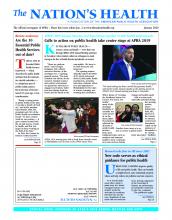Investing in your health is always a good decision. But when it comes to exercise, you don’t need to spend a lot of money. While ads may try to convince you that you need fancy equipment or pricey gym memberships, many of the best ways to exercise are free.
Adults should get somewhere between 150 and 300 minutes of moderate to intense exercise per week, according to U.S. fitness guidelines. On the more moderate side, this includes things like brisk walking or even yard work. If you spread that out evenly, that’s around 30 minutes of exercise per day. Only about 25% of men and 20% of women and kids meet that goal.

For more exercise ideas and guidelines, visit www.cdc.gov/physicalactivity
So how can you fit in more activity without breaking the bank? Carissa Smock, PhD, MPH, an associate professor at Northcentral University, says that you already have access to a great way to exercise for free: Your local parks.
“Parks and trails are an incredible, freely available, access point to fitness,” says Smock, chair of APHA’s Physical Activity Section.
Parks are great choice for a range of exercises and abilities. And they’re kid friendly, so you can double-up on the benefits if you bring family. Science shows that being in nature is good for your mental health too, helping reduce your stress levels.
Walking and running are the most obvious and easiest ways to exercise for free. But there are a lot of other great low- or no-cost options out there.
Get it together
When you’re at your local café or diner, take a look at the bulletin board. Community groups and faith-based organizations often offer free exercise classes.
Walking groups, tai chi meetups and sports teams are common examples of community-sponsored exercise. You may be able to get in some exercise and befriend a few neighbors at the same time.
Be on the lookout for free yoga opportunities as well. Yoga classes at a studio can be pricey. But inexpensive community yoga classes — such as through your local senior center, library or hospital — are common. In warmer months, many communities offer free yoga outdoors too.
And once you know the basics, you can do yoga almost anywhere, including your home or a park, for free.
Try before you buy
A lot of gyms, clubs and studios offer free or inexpensive trials. It’s not a long-term plan for fitness, but it can be an effective way to find what works for you.
You could be taking a spin class one day and kickboxing another. But don’t cram in too much to get the most out of your trial, or you could overdo it.
If you don’t want to commit to a long-term contract, see if they have a drop-in option, which allows you to pay per day or class.
Another type of exercise where you can try before you buy is cycling. If you want to make cycling part of your regular routine, the cost of a bike can be a barrier. And you don’t want to spend a lot just to find out you hate doing it.
The good news is that you can try out cycling through a bike rental or bike-share program.
Bike sharing has become increasingly popular across the U.S., especially in cities and on campuses. The programs allow you to quickly and easily rent a bike for a short amount of time. Check for pricing discounts, which may be available for students, seniors or people with low incomes.
In the long term, if you decide to make cycling a part of your regular routine, you’ll save money by buying your own bike. No matter what you choose, don’t ride without a helmet.
Take it online
Working out at home is nothing new. But it’s more accessible than ever now.
The internet has a wealth of free exercise videos you can try, from 10-minute weight routines to YouTube channels with a year’s worth of yoga classes.
Searching for phrases such as “fitness at home,” “30-day yoga,” or “Zumba class” will give you a variety of options for a new routine. Quality can vary, though, so look for online instructors who are certified or licensed in what they’re teaching.
Also, if you’re starting something new online, it’s a good idea to find a class or two in real-life first. That way you can learn the basics and reduce the chances you’ll injure yourself while exercising alone at home.
Find your time to be active
Setting aside dedicated time for exercise can be hard. A good way to start is to just be less inactive. Any amount of physical activity is good for your health.
Get off the bus one stop sooner and walk an extra block. Park farther away from the store when you get groceries. Once you’re in the habit of moving more, you’ll be ready to take in a quick game of basketball with friends at lunch.
If you can squeeze in a few minutes here and there, take the opportunity. It all adds up.
- Copyright The Nation’s Health, American Public Health Association









